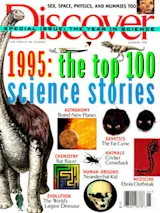The spacecraft Galileo has endured a lot: launch delays, environmentalist protests (it carries a small amount of plutonium as a power source), and, after it was finally launched from the space shuttle, a malfunctioning tape recorder and a faulty radio antenna that cut its data transmission rate by a factor of 840. In the six years since it was launched, Galileo has been spiraling through the inner solar system, looping by Earth twice for gravity boosts, on a 2.35-billion-mile trajectory that may well be the most circuitous route ever taken by anyone or anything to get anywhere. But on the way, the scrappy probe delivered the goods: a look at the dark side of the moon, the first close-up of an asteroid, and a spectacular view of comet Shoemaker-Levy 9. And by the time you read this, Galileo may finally have gotten where it’s going. On December 7--after this issue of DISCOVER had gone to press--the spacecraft was scheduled to settle into orbit around Jupiter. The fate of the Mars Observer, which expired on the eve of its own triumph in 1993, cannot have been far from the minds of Galileo’s handlers last fall.
One part of Galileo was supposed to die on December 7: the 747- pound probe that the spacecraft had released back in July, which was set to plunge straight into Jupiter’s 5,000-mile-thick atmosphere. Mission planners were hoping the probe would survive an hour, reaching a depth of 400 miles and transmitting back to Galileo the first direct measurements of the atmosphere’s temperature, density, and composition, before it would be crushed and melted. Galileo was programmed to put itself into a stabilizing spin shortly after receiving those data and to burn its rockets for just long enough--about 49 minutes--to push it into permanent orbit about the giant planet.
If all goes well, the orbiter will make at least ten passes at Callisto, Europa, Ganymede, and Io--the moons that Galileo Galilei saw through his first tiny telescope in 1610, and that were visited so briefly by the Voyager probes--before it is silenced by radiation damage and a lack of fuel. We plan to keep gathering data until the end of 1997, deputy mission director Matt Landano said in the fall. After that, the spacecraft may still be working fine. I don’t think anybody can say when it will die.














